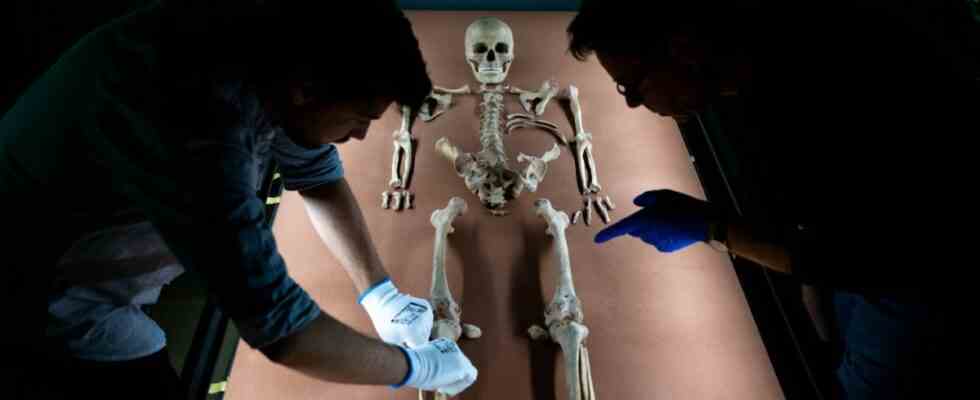What a story: In 1934, during sewer works, an ancient grave equipped with rich gifts was found in Bad Dürrenberg in Saxony-Anhalt. The prehistorians of the Nazis immediately pounce on it, see the Urarian in the find and believe that they can use it to prove that the Aryans “emerged” right here in Central Germany. So no migration, but grew up directly from blood and soil. These are all unfounded allegations by so-called scientists who were either in the service of the Rosenberg office or the competing positions of SS chief Heinrich Himmler.
They are all so obsessed with Aryan mania that they even fail to notice that it is a female skeleton and that there are also bones from a small child. The grotesque writings of the Nazi researchers are documents of ideology, arbitrariness and unscientific quality of the first order. Some of these are now in the basement of the State Museum of Prehistory and Early History in Halle.
Archaeogenetics is the chemical analysis of the smallest particles of soil, paint residues and bone fragments
From 2019 onwards, the old excavation site was excavated again, this time not out of necessity, but to recover and properly evaluate everything that was still there and overlooked. Harald Meller, state archaeologist of Saxony-Anhalt and director of the Halle Museum, and Kai Michel, historian and literary scholar, have now – after their joint bestseller about the Nebra sky disc – told the story of that ominous woman in the grave of Dürrenberg. At the same time, her new book “The Shaman’s Riddle” is also a thoughtful and captivating “novel” of the kind of modern scientific methods that can be used to discover incredible things about someone who lived more than 9000 years ago. Archaeogenetics means the chemical analysis of the smallest particles of soil, paint residues and bone fragments.
But in the book the authors also try to check their own steps with great skepticism and caution in order not to succumb to the temptation to explain the ancient lady and her living conditions with projections from today’s ethnographic, sociological or psychological knowledge and assumptions. They explain in detail the problematic use of the term shaman, which is immediately at hand when such a special grave is found. One learns that the term is borrowed from the language of a Siberian people and that first the Christianization, but later also the Stalinist Soviet policy wanted to wipe out the Siberian shamans. The authors explain the phenomenon of the animism of plants, animals, landscapes and rocks in today’s hunter-gatherer populations in a similarly complex way, without simply closing 9000 years back to the Mesolithic.
All of this reads as exciting as it is enlightening, gradually the lady even becomes almost familiar. The exact scientific examination of the genome makes it possible to get a very precise picture of the old woman from Dürrenberg: light eyes, dark skin, dark hair. In the course of the research, there is also a lot of hard evidence and reliable evidence that the deceased must have been a very important person, otherwise this important grave in a prominent location would never have existed. And the many different accessories show that she must have been “a medical expert”, commonly known as a shaman. The fact that 600 years later two deer antler masks were placed near her grave shows that her importance was passed on from generation to generation.
Meller and Michel are also not shy about discussing trance, intoxication, journeys into the afterlife, mind-altering drugs, meditation, spirituality and religion, elements immediately associated with shamanism, promoted in the 1960s by the Romanian religious scholar Mircea Eliade, for example and thus brought it back to life (which, however, had little to do with the Siberian origins of the phenomenon). In this way, the authors move casually from human history to socio-political philosophizing. In other words: The magic of the old lady from Bad Dürrenberg with all her accessories is still working today. And when reading the book, one sometimes feels strangely and concretely what the richly buried woman from the Mesolithic must undoubtedly have had during her lifetime: charisma.
Harald Meller, Kai Michel: The enigma of the shaman: An archaeological journey to our beginnings. Rowohlt Verlag, Hamburg 2022. 368 pages, 28 euros.

